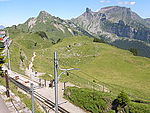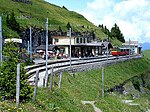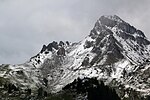Schynige Platte Railway

The Schynige Platte Railway (German: Schynige Platte-Bahn, SPB) is a mountain railway in the Bernese Highlands area of Switzerland, which connects the town of Wilderswil, near Interlaken, with the famous wildflower gardens of the Schynige Platte.An impressively and varied natural landscape unfolds on the journey, including forests, Alpine pastures and views of the Bernese Oberland. Towards the top of the line, there are also views of the imposing peaks of the Eiger, Mönch and Jungfrau. The line opened, using steam traction, in May 1893, and was electrified in 1914.The line is owned by the Berner Oberland-Bahnen AG, a company that also owns the Berner Oberland-Bahn. Through that company it is part of the Allianz - Jungfrau Top of Europe marketing alliance, which also includes the separately owned Wengernalpbahn, Jungfraubahn, Bergbahn Lauterbrunnen–Mürren, Harderbahn, and Firstbahn.
Excerpt from the Wikipedia article Schynige Platte Railway (License: CC BY-SA 3.0, Authors, Images).Schynige Platte Railway
Panoramaweg,
Geographical coordinates (GPS) Address Nearby Places Show on map
Geographical coordinates (GPS)
| Latitude | Longitude |
|---|---|
| N 46.656858333333 ° | E 7.9049638888889 ° |
Address
Panoramaweg
Panoramaweg
3814
Bern, Switzerland
Open on Google Maps











